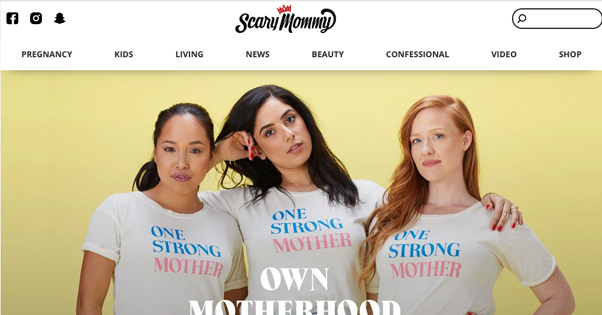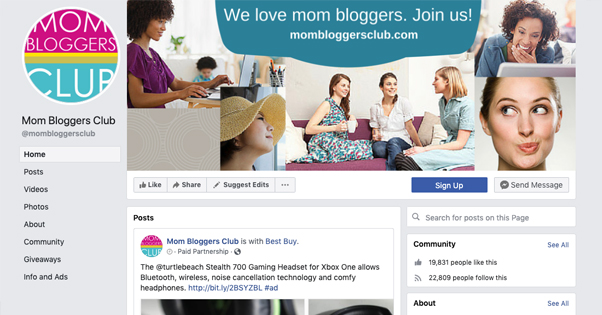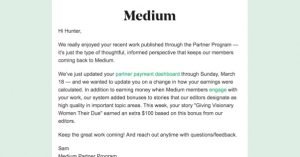15 Ways to Start a Mommy Blog That Actually Earns Money
Published by Drew Hendricks • Monetization • Posted May 2, 2019 ContentPowered.com
ContentPowered.com
There are two major powerhouses in the world of blogging. One is the marketing blogger niche, the people who analyze the trends, who set the stage, who push forward and explore the unknown every day.
The other is the mommy blogger niche. These are the bloggers who truly put all the advice into practice, because for them it’s a matter of life and finances. Many marketers can just go get jobs in other forms of marketing, or use their blogs as a means to an end. Mommy bloggers are in it for the love of blogging, for the desire to support their families, and to share their lives with others.
Sometimes the mommy blog gets a bit of a bad rap, and it’s understandable. It’s easy to read and half-understand a blogging tips articles, and put those tips into practice the best way you can. Maybe you’re not doing it exactly properly as a marketer would, but when your blog is hugely successful, does it really matter?
Starting a new mommy blog is tricky business, because it’s quite frankly an incredibly saturated industry. The great recession coupled with the issues finding jobs, the issues keeping stable careers, and the general state of the world today have all led to a huge population of stay at home or working moms deciding to run blogs as a way to survive. To start one now, you need to get ahead of the game, and you need to stand out from the rest.
Unfortunately, that means you can’t just start up a blog and run it half-cocked in hopes that you’ll be successful just like those others you read and admire. Maybe lightning will strike, but chances are a lot higher that you need to put in the elbow grease to even have a chance.
1. Set Reasonable Expectations
The first thing you need to do is be reasonable with what you want to do, what you want to offer, and what you can provide. You see a lot of the modern mommy blogs offering everything, these days. They do some affiliate marketing, they run their own Etsy store, they offer to sell their own consulting or advice courses, they give you coupons to promote this or that service, it just goes on and on.
The key is to realize that these sites have had years and, in some cases, decades to build up to this point. Unless you’re already an expert and a teacher, you aren’t going to go into it offering courses to teach others how to succeed. You can promote affiliate links, but you need the authority of “why should I trust this person” before you can get anywhere with them.
It’s important to recognize that it may take half a year, a full year, or even several years before you build up your site to the point where it will be profitable. If you quit your job hoping to run a successful blog, you may quickly find that to be a mistake.
2. Start with WordPress
There are a lot of different blogging platforms out there, and many of them are free, so “a system you have to set up on hosting you pay for with a domain name you also pay for” is a hard sell when I just told you that you probably won’t be making money for a long time yet. Still, hosting is cheap, domains are cheap, and WordPress is free. Plus, WordPress gives you such a wide array of possible tools and themes to expand your site functionality, it’s basically not worth considering other platforms.
What plugins should you get? Here’s a list of plugins we recommend, and here’s another list of premium plugins that are generally worth the money. If you prefer to mimic an existing site, you can also find what plugins they’re using and copy their setup.
3. Pick a Good Domain Name
Your domain name will be your branding, the name you go by, and it will be increasingly difficult to change as you grow and build upon that brand. You need to pick something that reflects the angle you want to pursue with your blogging career.
Some mommy blogs identify themselves by their starting point, others by what they’re trying to achieve, and others by a sub-niche. You have Motherly, you have Scary Mommy, you have Scary Mommy, you have Rockin’ Mama, you even have StartAMomBlog. Keeping the mom niche isn’t even strictly necessary, though if you’re aiming at a motherly kind of audience, it’s a good place to start.
4. Do Some Reading
Before you really dig into blogging, you need to do some basic reading. You wouldn’t start a carpentry project by picking up a bandsaw, and you wouldn’t start a knitting project without learning some basic patterns, so why start a blog if you don’t know how blogging works?
Here are some recommendations for places you can start your learning:
- This easy guide to the blogging basics from Blogging Basics 101
- This list of things the author wishes they knew before getting started from CodeInWP
- Neil Patel’s guide on how to start a blog
- The rest of the site you’re currently reading, of course
The internet is just packed with good information, so long as you know how to sort through it. I’d recommend generally aiming to read content from big names and content published in the last year or two. The older the content, the more likely there are to be inaccuracies, so be careful on that front.
5. Generate Ideas
Before you put digital pen to digital paper, you really need to figure out what, specifically, you want your angle to be. What makes you different from every other mommy blogger out there? Do you have particular interests, knowledge, history, or even a day job that you can use for a unique perspective? You have a distinct voice, though you may not know how to write with it just yet. Don’t worry too much; that will come with practice.
Brainstorm ideas for possible blog posts. What can you write about and what perspective can you bring to it? Not all of your ideas need to be winners; you’re just brainstorming for now. Just jot down topics, ideas, doodles, whatever comes to mind. Look for patterns and perspectives that run through them, and drill down to find your niche.
The two keys to coming up with successful topics are finding ideas that you enjoy, and that others can enjoy as well.
6. Pick a Monetization Strategy
How do you want to make money? Running a blog is easy, but making money is a lot harder.
Different styles of monetization require a different approach, so it’s good to know what your end goal is while you’re still setting up.
- Display advertising. These ads are easy to set up, but won’t give you much returns until you have a very large audience, at which point other strategies can win out. However, it can be a good supplement the whole way through.
- Affiliate marketing. If you can think of products you use that you would recommend – anything from baking ingredients to gardening tools – you can link to them on Amazon with an accompanying blog post to make some money.
- Selling products. If you craft, knit, or otherwise produce anything, you can sell via an Etsy shop, eBay storefront, Amazon webstore, or even a personal store operated with WordPress plugins. It’s more work, since you have to handle production, shipping, inventory, and all the rest, but it can be very rewarding.
- Selling education. Many bloggers, once they reach a certain level of fame and success, find themselves flooded with people asking them how to replicate their success. Some of those bloggers produce web courses and sell consulting.
You’re not limited to just one, of course, but it’s a good idea to pick one to work towards, and then expand outwards later as the occasion arrives.
7. Start Writing Posts
The hardest part of blogging is writing something on a regular schedule. I often find that it helps to write a bunch of posts on one day and schedule them out for a few weeks, to maintain a buffer.
In fact, write a bunch of posts – as many as a dozen – before you even publish the first one. Get started on the right foot and you’ll be able to hit the ground running.
8. Spice Up Posts with Images and Links
Before you publish your posts, you want to spice them up. Every post should have a few links to other blogs and other posts, content that helps your readers understand what you’re talking about. A few images will also be helpful, though you don’t need to go overboard with them. Just remember that you either need to produce the images your self or you need to get them from a legal source: image copyright is a real issue.
9. Do Basic Keyword Research
Keyword research is something of a trap. It’s essential to capturing a good audience, but too many bloggers do the keyword research before they write, end up writing about topics that they don’t care about, and produce mediocre content that goes nowhere.
By writing your content first, you can do some research to figure out what keywords can work, and you can make a few edits to include them in a natural way. Of course, it helps to understand how modern keyword research – and modern Google search – actually work today.
10. Publish Your First Post
Once you have a bunch of posts written, you can publish your first post on your new blog. Don’t stress too much about it: most people aren’t going to go back and read it after a few weeks have passed anyways. In fact, it’s not a terrible idea to publish 6+ posts in the first week or so, to give Google and your potential readers at least a handful of content to explore when they first show up.
11. Schedule Plenty of Posts in Advance
At this point you need to decide on a schedule. Personally, I prefer weekly posts. One post per week, when the post is of a sufficiently length and quality level, works quite well.
Trying to write one post every weekday is a very quick road to burnout, and far too many bloggers decide to take that path and end up crashing and burning. Less frequent posts, however, generally mean you aren’t capturing the full value of a dedicated audience. Two weeks is more than enough time for people to forget who you are.
12. Start Engaging with Other Bloggers
The key to building an early community is actually to network. Thankfully, the mommy blogger network is generally pretty nice, open, and accustomed to building a community. Pick your favorite mommy blogs and start reading them regularly. Read them to learn their styles, their topics, their perspectives, and how they engage with their audience. Most importantly, leave comments! Most comment systems let you put your website in a profile field, so do that, but don’t make it the front and center element of your
13. Join Mommy Blogging Groups
Facebook Groups can be a great place to build an audience, make friends, network, and generally build a successful site.
This is a pretty good guide on how to find and use Facebook groups to grow a new blog. Some of the tips aren’t strictly applicable to a new mommy blog, but many of them can be adapted.
14. Start a Few Social Profiles
One key element that puts a mommy blog above many others is the ability to be casual and social. You don’t have a corporate brand to reflect, you can just be friends with people. Social profiles – a Facebook page, a Twitter account, maybe a Pinterest or Instagram account – can bring you to that audience, and more importantly, bring that audience to you.
15. Keep At It
At the end of the day, the number one trait you need to make a successful, monetized blog is persistence. Keep at it, every week, until you’re either dead broke or you succeed. Given how cheap it is to run a blog, the latter should happen first.














